1998 GMC SIERRA ECU
[x] Cancel search: ECUPage 245 of 452
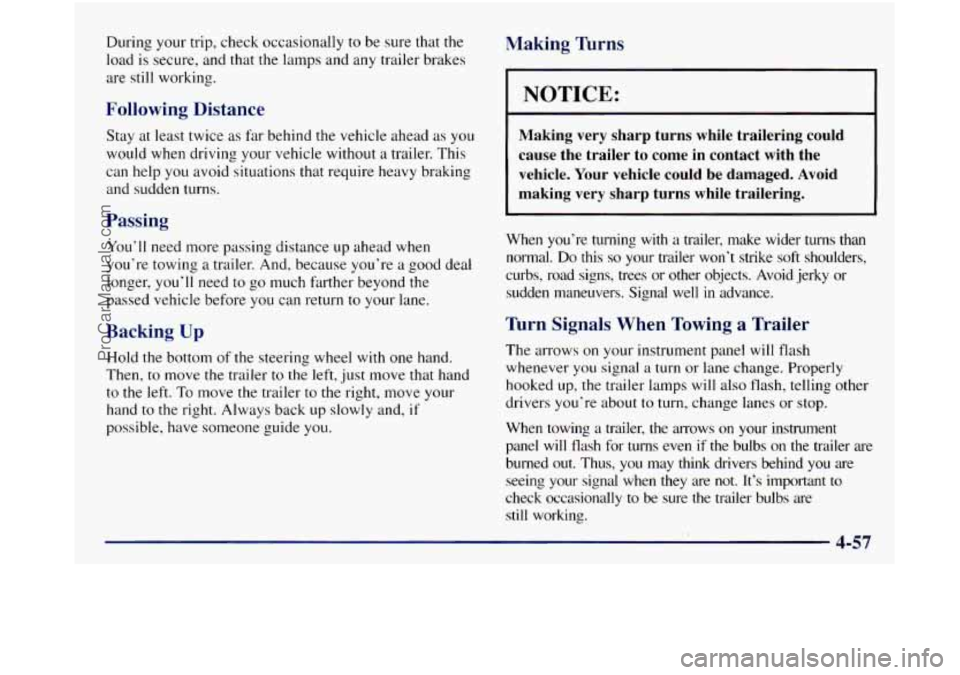
During your trip, check occasionally to be sure that the
load is secure, and that the lamps and any trailer brakes
are still working.
Following Distance
Stay at least twice as far behind the vehicle ahead as you
would when driving your vehicle without
a trailer. This
can help
you avoid situations that require heavy braking
and sudden turns.
Passing
You’ll need more passing distance up ahead when
you’re towing a trailer. And, because you’re a good deal
longer,
you’ll need to go much farther beyond the
passed vehicle before you can return to
your lane.
Backing Up
Hold the bottom of the steering wheel with one hand.
Then, to move the trailer
to the left, just move that hand
to the left.
To move the trailer to the right, move your
hand to the right. Always back up slowly and, if
possible, have someone guide you.
Making Turns
I NOTICE:
Making very sharp turns while trailering could
cause the trailer to come in contact with the
vehicle. Your vehicle could be damaged. Avoid
making very sharp turns while trailering.
When you’re turning with a trailer, make wider turns than
normal. Do this
so your trailer won’t strike soft shoulders,
curbs, road signs, trees or other objects. Avoid jerky or
sudden maneuvers. Signal well in advance.
Turn Signals When Towing a Trailer
The arrows on your instrument panel will flash
whenever
you signal a turn or lane change. Properly
hooked up, the trailer lamps will also flash, telling other
drivers you’re about to turn, change lanes or stop.
When towing a trailer, the arrows on your instrument
panel
will flash for turns even if the bulbs on the trailer are
burned out. Thus,
you may think drivers behind you are
seeing your signal when they are not. It’s important to
check occasionally
to be sure the trailer bulbs are
still working.
ProCarManuals.com
Page 261 of 452
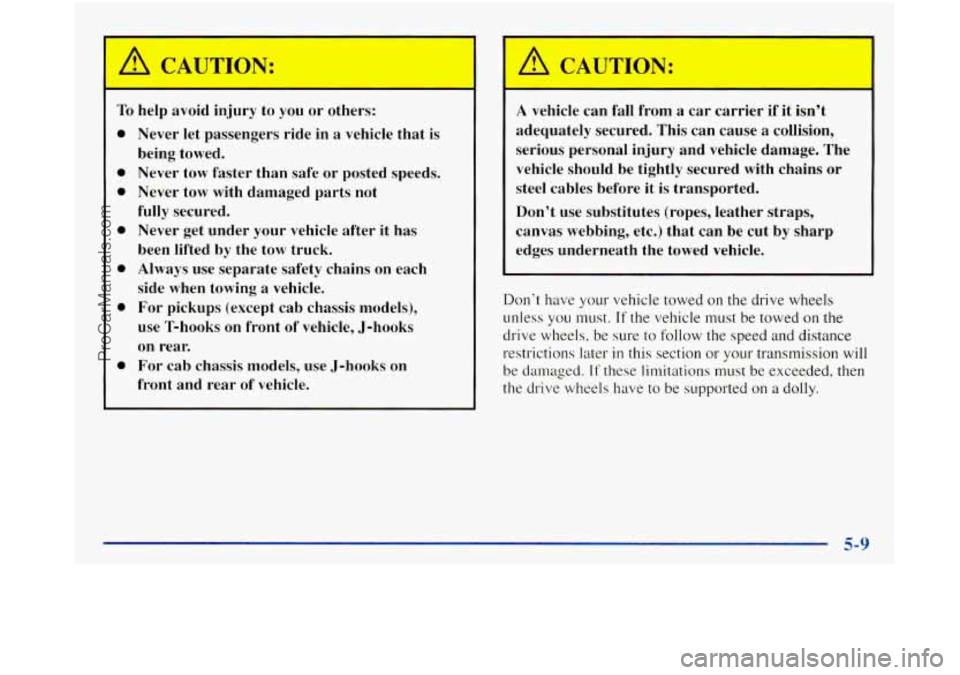
A CAUTION:
To help avoid injury to you or others:
0
0
0
0
0
a
0
Never let passengers ride in a vehicle that is
being towed. Never tow faster than safe or posted speeds.
Never tow with damaged parts not
fully secured.
Never get under your vehicle after it has
been lifted by the tow truck.
Always use separate safety chains on each
side when towing a vehicle.
For pickups (except cab chassis models),
use T-hooks on front of vehicle, J-hooks
on rear.
For cab chassis models, use J-hooks on
front and rear of vehicle.
A CAUTION:
A vehicle can fall from a car carrier if it isn’t
adequately secured. This can cause a collision,
serious personal injury and vehicle damage. The
vehicle should be tightly secured with chains or
steel cables before it is transported.
Don’t use substitutes (ropes, leather straps,
canvas webbing, etc.) that can be cut by sharp
edges underneath the towed vehicle.
Don‘t have your vehicle towed on the drive wheels
unless you must.
If the vehicle must be towed on the
drive wheels. be sure to follow the speed and distance
restrictions later
in this section or your transmission will
be damaged. If these limitations must be exceeded, then
the drive wheels have
to be supported on a dolly.
5-9
ProCarManuals.com
Page 286 of 452
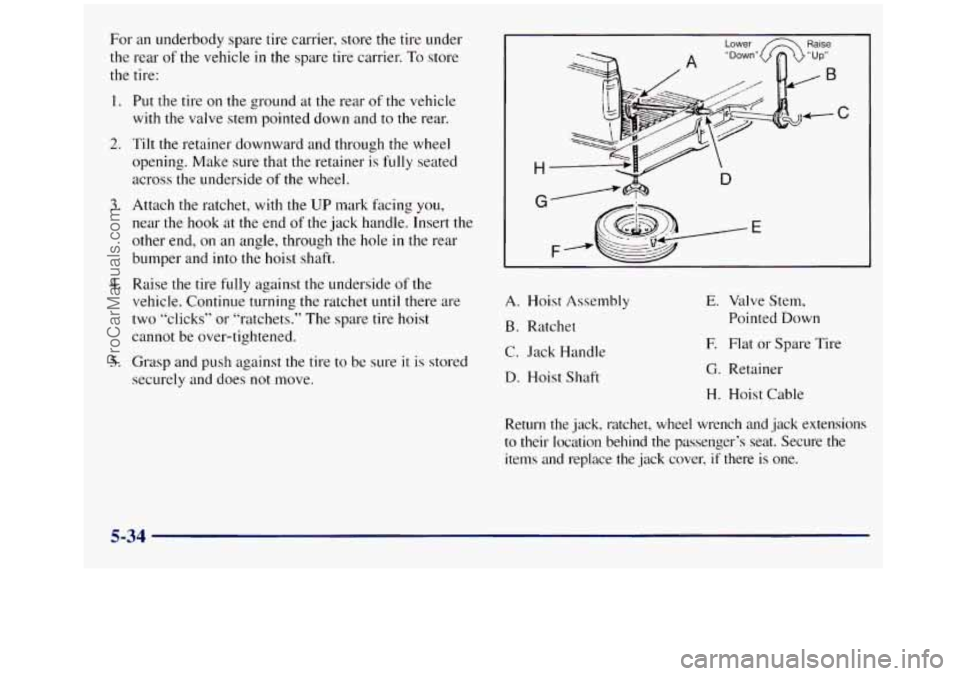
For an underbody spare tire carrier, store the tire under
the rear
of the vehicle in the spare tire carrier. To store
the tire:
1.
2.
3.
4.
5.
Put the tire on the ground at the rear of the vehicle
with the valve stem pointed down and to the rear.
Tilt the retainer downward and through the wheel
opening. Make sure that the retainer
is fully seated
across the underside
of the wheel.
Attach the ratchet, with the
UP mark facing you,
near the hook at the end
of the jack handle. Insert the
other end, on an angle, through
the hole in the rear
bumper and into the hoist shaft.
Raise the tire fully against
the underside of the
vehicle. Continue turning
the ratchet until there. are
two “clicks” or “ratchets.” The spare tire hoist
cannot be over-tightened.
Grasp and push against the tire to be sure
it is stored
securely and does not move.
I Lower Raise
A. Hoist Assembly
B. Ratchet
C. Jack Handle
D. Hoist Shaft
E. Valve Stern,
Pointed Down
E Flat or Spare Tire
G. Retainer
H. Hoist Cable
Return the jack, ratchet, wheel wrench
and jack extensions
to their location behind the passenger’s seat. Secure the
items and replace the jack cover,
if there is one.
5-34
ProCarManuals.com
Page 351 of 452
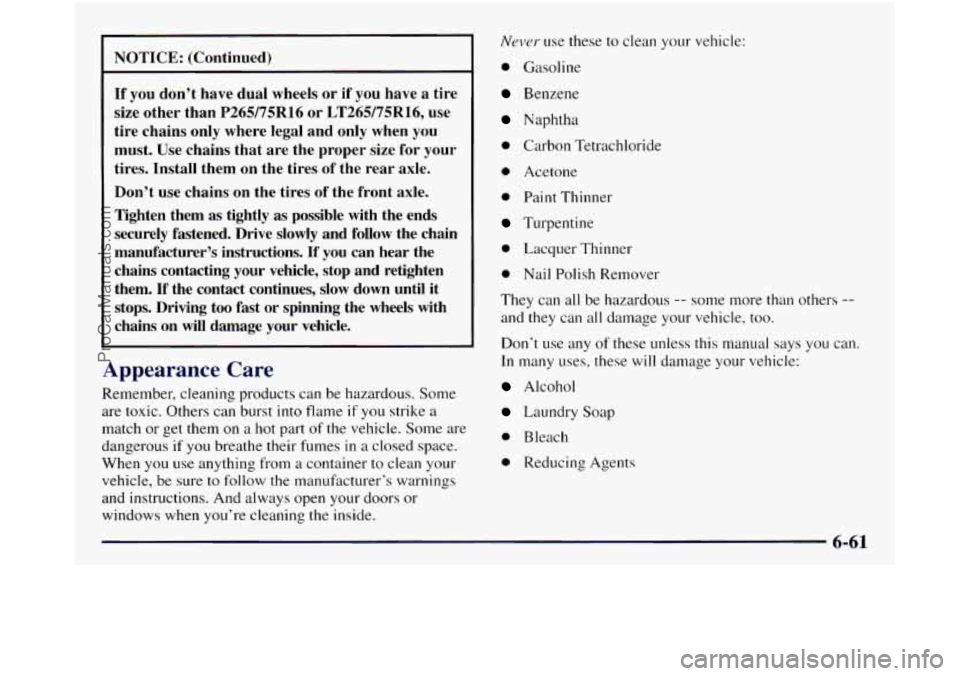
NOTICE: (Continued) -
If you don’t have dual wheels or if you have a tire
size other than
P265/75R16 or LT265/75R16, use
tire chains only where legal and only when you
must. Use chains that are the proper size for your
tires. Install them on the tires of the rear axle.
Don’t use chains on the tires of the front axle.
Tighten them
as tightly as possible with the ends
securely fastened. Drive slowly and follow the chain
manufacturer’s instructions. If you can hear the
chains contacting your vehicle, stop and retighten
them.
If the contact continues, slow down until it
stops. Driving too fast or spinning the wheels with
chains on will damage your vehicle.
Appearance Care
Remember, cleaning products can be hazardous. Some
are toxic. Others can burst into flame
if you strike a
match or get them on
a hot part of the vehicle. Some are
dangerous if
you breathe their fumes in a closed space.
When you use anything from
a container to clean your
vehicle, be sure
to follow the manufacturer’s warnings
and instructions. And always open your doors or
windows when you’re cleaning the inside.
NevcJr use these to clean your vehicle:
0 Gasoline
Benzene
Naphtha
0 Carbon Tetrachloride
0 Acetone
0 Paint Thinner
Turpentine
0 Lacquer Thinner
0 Nail Polish Remover
They can
all be hazardous -- some more th .an others --
and they can all damage your vehicle, too.
Don’t use any
of these unless this manual says you can.
In many uses, these will damage your vehicle:
Alcohol
Laundry Soap
0 Bleach
0 Reducing Agents
6-61
ProCarManuals.com
Page 364 of 452

Fuse/Circuit Breaker Usage
20
21
22
23
24
A
B
PRNDL, Automatic Transmission,
Speedometer, Check Gages
Warning Light
Security/Steering
Not Used
Not Used
Front Axle,
4WD Indicator Lamp,
TP2 Relay (Gasoline Engine)
Power Door Lock, Six-Way Power Seat, Keyless Entry Module
Power Windows
Underhood Fuse/Relay Center
The underhood fusehelay center is located in the rear of
the engine compartment near the brake fluid reservoir.
Move the retainer clips
for the cover to access the
fuse block.
You can remove fuses with a fuse extractor. The fuse
extractor
is mounted to the interior fuse block. TO
remove fuses
if you don’t have a fuse extractor, hold the
end of the fuse between your thumb and index finger
and pull straight out.
6-74
ProCarManuals.com
Page 443 of 452
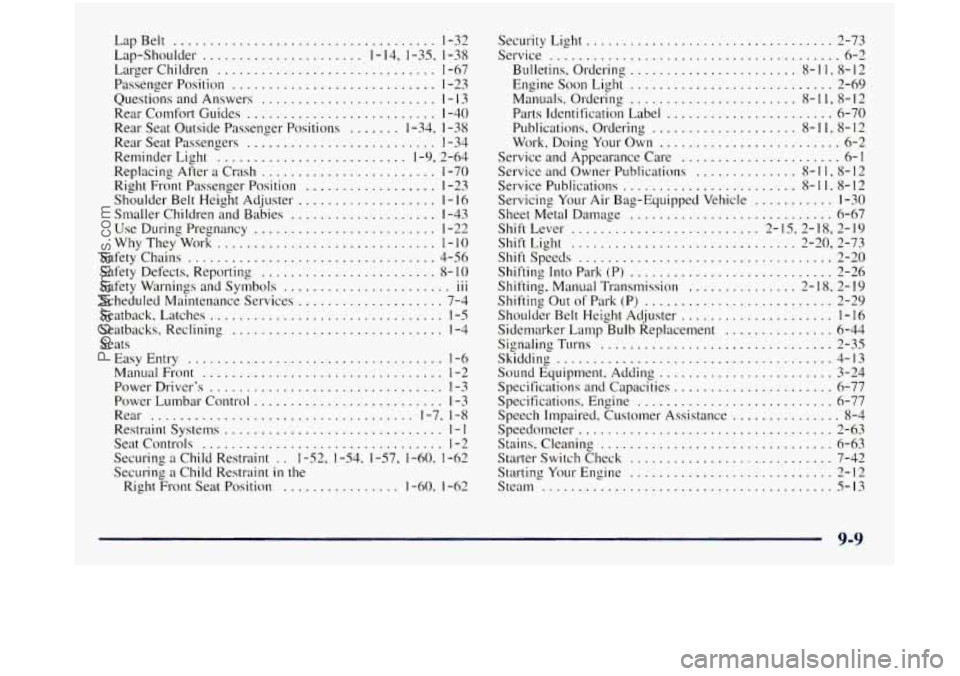
LapBelt .................................... 1-32
Lap-Shoulder
...................... 1.14. 1.35. 1-38
Larger Children
.............................. 1-67
Passenger Position
............................ 1-23
Questions and Answers
........................ 1 . I3
Rear Comfort Guides .......................... 1-40
Rear Seat Outside Passenger Positions ....... 1.34. 1-38
Rear Seat Passengers
.......................... 1-34
Reminder Light .......................... 1.9. 2.64
Replacing After a Crash ........................ 1-70
Right Front Passenger Position
.................. 1-23
Smaller Children and Babies
.................... 1-43
Use During Pregnancy ......................... 1.2 2
Safety Chains
.................................. 4-56
Safety Defects. Reporting
........................ 8- IO
Safety Warnings and Symbols ....................... 111
Scheduled Maintenance Services .................... 7-4
Seatback. Latches
................................ 1-5
Seatbacks. Reclining ............................. 1-4
Seats
Easy Entry
................................... 1-6
Manual Front ................................. 1-2
Power Driver's
................................ 1-3
Power Lumbar Control .......................... 1-3
Rear .................................... 1-7.1-8
Restraint Systems .............................. 1 -I
Seat Controls ................................. 1-2
Securing a Child Restraint . . 1.52. 1.54 . 1.57. 1.60. 1-62
Securing
a Child Restraint in the
Right Front Seat Position ................ 1.60 . 1-62
Shoulder
Belt Height Adjuster
................... I . 16
WhyThey Work .............................. 1-10
...
Security Light .................................. 2-73
Service
........................................ 6-2
Engine Soon Light
............................ 2-69
Manuals
. Order~ng ....................... 8- 1 1. 8- I2
Parts Identification Label ....................... 6-70
Publications. Ordering
.................... 8- I 1.8- 12
Work. Doing Your Own
......................... 6-2
Service and Appearance Care
...................... 6-1
Service and Owner Publications .............. 8- I 1. 8- 12
Service Publications
........................ 8- I I . 8-12
Servicing Your Air Bag-Equipped Vehicle
........... 1-30
Sheet Metal Damage
............................ 6-67
Shift Lever
.......................... 2- 15. 2- 18. 2- I9
Shift Light ............................... 2-20.2-73
Shift Speeds
................................... 2-20
Shifting Into Park
(P) ............................ 2-26
Shifting
. Manual Transmission ............... 2- 18. 2- I9
Shifting Out of Park (P) .......................... 2-29
Shoulder Belt Height Adjuster
..................... 1 -16
Sidemarker Lamp Bulb Replacement ............... 6-44
Signaling TU~M
................................ 2-35
Skidding
...................................... 4-13
Sound Equipment. Adding ........................ 3-24
Specifications and Capacmes 6-77
Specifications
. Engine ........................... 6-77
Speech Impaired. Customer Assistance
............... 8-4
Speedometer ................................... 2-63
Stains. Cleaning
................................ 6-63
Starter Switch Check
............................ 7-42
Starting Your Engine
............................ 2-12
Steam ........................................ 5-13
Bulletins.
Ordering
....................... 8- I 1 . 8-12
.. ......................
9-9
ProCarManuals.com